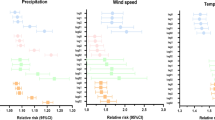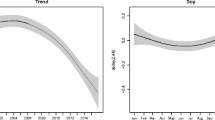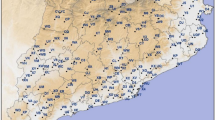Abstract
Summary
Observation-driven Poisson regression models were used to investigate mean daily air temperature and fall-related hip fracture hospitalisations. After adjustment for season, day-of-week effects, long-term trend and autocorrelation, hip fracture rates are higher in both males and females aged 75+ years when there is a lower air temperature.
Introduction
This study investigated whether there was an association between fall-related hip fracture hospitalisations and air temperature at a day-to-day level, after accounting for seasonal trend and autocorrelation.
Methods
Observation-driven Poisson regression models were used to investigate mean daily air temperature and fall-related hip fracture hospitalisations for the period 1 July 1998 to 31 December 2004, inclusive, in the Sydney region of New South Wales, Australia, which has a population of 4 million people.
Results
Lower daily air temperature was significantly associated with higher fall-related hip fracture hospitalisations in 75+-year-olds: men aged 75–84 years, rate ratio (RR) for a 1°C increase in temperature of 0.98 with 95% confidence interval (0.96, 0.99), men 85+ years RR = 0.98 (0.96, 1.00), women 75–84 years RR = 0.99 (0.98, 1.00), women 85+ years RR = 0.98 (0.97, 0.99). Moreover, there were fewer hospitalisations on weekends compared to weekdays ranging from RR = 0.81 (0.73, 0.90) in women aged 65–74 years to RR = 0.89 (0.80, 0.98) in men aged 85+ years.
Conclusions
After adjustment for season, day-of-week effects, long-term trend and autocorrelation, fall-related hip fracture hospitalisation rates are higher in both males and females aged 75+ years when there is a lower air temperature.


Similar content being viewed by others
References
Sanders KM, Nicholson GC, Ugoni AM, Pasco JA, Seeman E, Kotowicz MA (1999) Health burden of hip and other fractures in Australia beyond 2000. Projections based on the Geelong Osteoporosis Study. Med J Aust 170:467–470
Jacobsen SJ, Goldberg J, Miles TP, Brody JA, Stiers W, Rimm AA (1991) Seasonal variation in the incidence of hip fracture among white persons aged 65 years and older in the United States, 1984–1987. Am J Epidemiol 133:996–1004
Lau EMC, Gillespie BG, Valenti L, O'Connell D (1995) The seasonality of hip fracture and its relationship with weather conditions in New South Wales. Aust J Public Health 19:76–80
Pedrazzoni M, Alfano FS, Malvi C, Ostanello F, Passeri M (1993) Seasonal variation in the incidence of hip fractures in Emilia-Romagna and Parma. Bone 14(Suppl 1):S57–63
Chesser TJS, Howlett I, Ward AJ, Pounsford JC (2002) The influence of outside temperature and season on the incidence of hip fractures in patients over the age of 65. Age Ageing 31:343–348
Levy AR, Bensimon DR, Mayo NE, Leighton HG (1998) Inclement weather and the risk of hip fracture. Epidemiology 9:172–177
Bulajic-Kopjar M (2000) Seasonal variations in incidence of fractures among elderly people [see comment]. Inj Prev 6:16–19
Mirchandani S, Aharonoff GB, Hiebert R, Capla EL, Zuckerman JD, Koval KJ (2005) The effects of weather and seasonality on hip fracture incidence in older adults. Orthopedics 28:149–155
Lin HC, Xiraxagar S (2006) Seasonality of hip fractures and estimates of season-attributable effects: a multivariate ARIMA analysis of population-based data. Osteoporos Int 17:795–806
The Australian Bureau of Statistics (2006) www.abs.gov.au
R Development Core Team (2008) R: A Language and Environment for Statistical Computing. R Foundation for Statistical Computing, Vienna
Davis RA, Dunsmuir WTM, Streett SB (2003) Observation driven models for Poisson counts. Biometrika 90:777–790
Boufous S, Finch CF, Lord SR (2004) Incidence of hip fracture in New South Wales: are our efforts having an effect? Med J Aust 180:623–626
Kannus P, Parkkari J, Koskinen S, Niemi S, Palvanen M, Jarvinen M, Vuori I (1999) Fall-induced injuries and deaths among older adults [see comment]. JAMA 281:1895–1899
Kannus P, Niemi S, Parkkari J, Palvanen M, Vuori I, Jarvinen M (1999) Hip fractures in Finland between 1970 and 1997 and predictions for the future [see comment]. Lancet 353:802–805
Sumukadas D, Witham M, Struthers A, McMurdo M (2009) Day length and weather conditions profoundly affect physical activity levels in older functionally impaired people. J Epidemiol Community Health 63:305–309
Boufous S, Finch C, Close J, Day L, Lord S (2007) Hospital admissions following presentations to emergency departments for a fracture in older people. Inj Prev 13:211–214
Hayen AD, Boufous S, Harrison JE (2007) A discussion of the potential benefits to injury surveillance through inclusion of date of injury in hospitalisation data in New South Wales and Australia. NSW Public Health Bull 18:130–132
Acknowledgements
Robin Turner was employed as part of the New South Wales Biostatistical Officer Training Program funded by the New South Wales Department of Health while undertaking this work based at the New South Wales Injury Risk Management Research Centre. Caroline Finch was supported by a National Health and Medical Research Council Principal Research Fellowship.
Conflict of interest
None.
Author information
Authors and Affiliations
Corresponding author
Rights and permissions
About this article
Cite this article
Turner, R.M., Hayen, A., Dunsmuir, W.T.M. et al. Air temperature and the incidence of fall-related hip fracture hospitalisations in older people. Osteoporos Int 22, 1183–1189 (2011). https://doi.org/10.1007/s00198-010-1306-2
Received:
Accepted:
Published:
Issue Date:
DOI: https://doi.org/10.1007/s00198-010-1306-2




